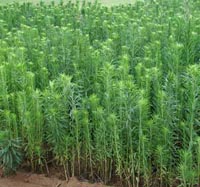Resource Library
Plant of the Week: Marestail (Horseweed)
The University of Arkansas System Division of Agriculture does not promote, support or recommend plants featured in "Plant of the Week." Please consult your local Extension office for plants suitable for your region.
Plant of the Week
Horseweed, Marestail
Latin: Conyza Canadensis

I always chuckle when I see Mother Nature beating the car hood with a stick in one of our current crop of commercials. I can’t remember what they’re trying to sell. but I do get the message that it’s not nice to fool Mother Nature. About the time we think we’ve brought her to her knees, she retaliates in some unpredictable way. An example of this is a Roundup-resistant weed giving cotton and soybean farmers in eastern Arkansas a run for their money.
What is Horseweed?
The weed is Horseweed or Marestail (Conyza canadensis), an annual weed once considered a minor problem, but now emerging as a significant threat, reducing yields up to 40 percent if left uncontrolled.
Horseweed is an opportunistic weed found in all corners of the country. It prefers dry, disturbed land and you’ve no doubt pulled an occasional weed from your flower or vegetable garden. Each fall, a single plant can produce 50,000 windborne seeds outfitted with a parasol, thus allowing it to drift far and wide on air currents.
The name marestail is descriptive because plants have a single, unbranched, five- or six-foot tall stems cloaked in willow-like leaves. Pea-sized greenish-white flowers appear in late summer and fall in large terminal clusters. Seeds germinate in the fall and plants can overwinter, but they also sprout in the spring and early summer if the soil is moist.
How did Horseweed become such a problem?
The emergence of horseweed as a major weed resulted from two changes in farming practices. First, farmers began using "conservation tillage," a cropping system that skipped plowing in favor of disking and chiseling. This technique left crop stubble on the field and reduced the exposure of bare ground to erosion. Also, conservation tillage allowed farmers to cover more ground in a day with larger equipment, thus reducing cost.
The second change was the widespread adoption of Roundup Ready® crops, which reached nearly 85 percent for Arkansas soybean acreage. Farmers could plant seeds into the stubble and then spray over the top with Roundup herbicide in a burndown treatment. In theory, only the resistant crop survived.
But horseweed didn’t get the memo. Resistance was reported in 2001 in two widely separated states, only five years after the technology became widely adopted. Resistance showed up in Arkansas in 2002. Some individual plants can be killed by two to three times heavier than normal doses, while others require as much as 12x rates to do the job.
And, at least according to one report, resistance is a dominant trait, so 75 percent of the offspring of resistant plants are resistant. Resistant plants look identical to Roundup susceptible plants, differing only in their internal biochemistry. Scientists studying the problem believe resistant plants block herbicide movement, thus minimizing cell damage.
Except for maybe a few gardeners with really large vegetable patches, the appearance of an herbicide resistant horseweed is not a big concern. Horseweed appears just here or there in most gardens and is easily controlled by pulling.
But, this is an interesting example of how the best laid plans of mice and men are often thwarted. The web of life is extremely elastic, and when pressure is applied in one area, adjustments occur in the rest of the web, and life goes on. The notion of a stable, unchanging environment is an illusion, for change - be it fast or slow - seems to be the one constant.
By: Gerald Klingaman, retired
Extension Horticulturist - Ornamentals
Extension News - August 5, 2005
The University of Arkansas System Division of Agriculture does not maintain lists of retail outlets where these plants can be purchased. Please check your local nursery or other retail outlets to ask about the availability of these plants for your growing area.